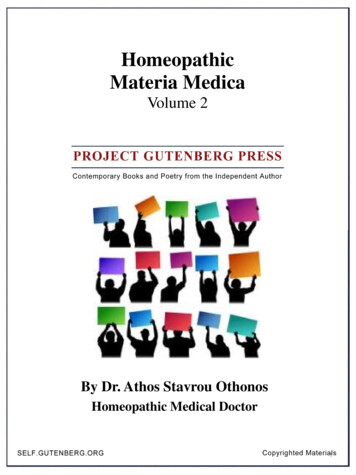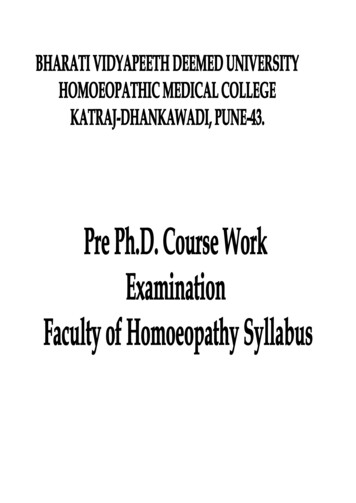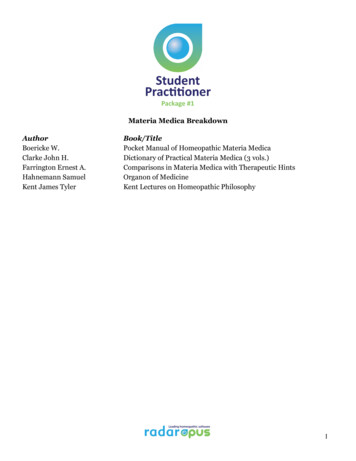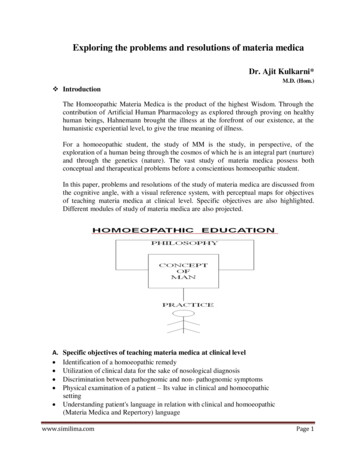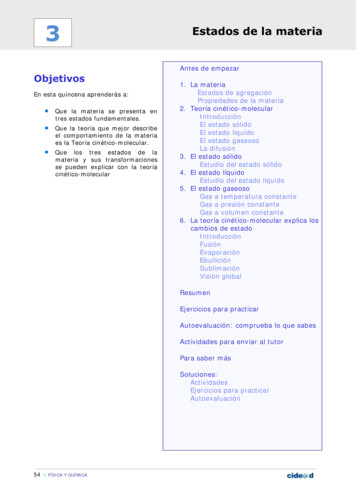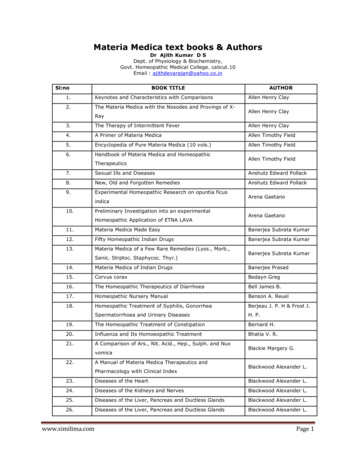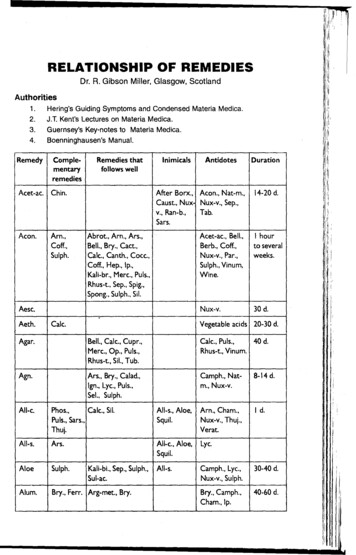
Transcription
The Materia Medica of the Nosodes.By Henry Clay ALLEN, M. D.Materia Medica of the Nosodes (Only Key-Notes).Ambra grisea * Anthracinum * Electricity * Lac caninum * Lac vaccinum * Lac vaccinum defloratum *Lyssin * Magnetis poli ambo * Magnetis polus arcticus * Magnetis polus australis * Malandrinum *Medorrhinum * Psorinum * Secale cornutum * Syphilinum * Tuberculinum * Ustilago * VariolinumoAMBRA GRISEA (Ambergris).Mind.- (Ambra grisea)II Comprehension slow, has to read everything three or four times and then does not understand it.II Distorted images, grimaces ; diabolical faces crowd upon his fancy.II Embarrassed manner in company ; blushing, bashful (Fer., X-ray, Tub.).II Fears of becoming insane.II Memory impaired.I After business embarrassment cannot sleep, must get up and walk about (Rhus r., Sep.).I Difficult thinking in the morning.I Is not able to reflect upon anything properly, feels stupid.I Melancholy, sits for days weeping ; with great weakness, loss of muscular power and pain in the small ofthe back and constipation.Sensorium.- (Ambra grisea)I Great weakness in the head with vertigo.I She had to lie down on account of vertigo and sensation of weakness in the stomach.I Vertigo with feeling of weight on the vertex ; after sleep, after eating.Head.- (Ambra grisea)II Falling off of hair, hair turns gray early.II Rush of blood to head caused by music.I On the right side of the head, a spot, where the hair when touched pains, as if sore.Ears And Hearing.- (Ambra grisea)
II Music aggravates the cough.I Deafness of one ear.I Hearing, decreases ; with cold sensation in abdomen.I Listening to music brings on congestion to head.I Roaring and whistling in ears, in afternoon.Nose.- (Ambra grisea)II Nosebleed with the menses.I Bleeding of the nose early in the morning.I Copious nosebleed early in bed, several successive days.I Dried blood gathered in nose.Teeth And Gums.- (Ambra grisea)I Bleeding of gums.Mouth.- (Ambra grisea)III Ranula.I Fetor of mouth, worse mornings.Throat.- (Ambra grisea)I Accumulation of grayish phlegm in throat, which is difficult to hawk up, accompanied by rawness.I Sensation of rawness in region of velum pendulum palati.I Sore throat after exposure to a draught of air ; stitching from the throat into right ear ; pains particularlyfrom motion of the tongue.Stomach. - (Ambra grisea)I After eating, cough and gaping or gagging ; anxiety ; pressure in pit of stomach, as if the food stuck andwould not go down (food descends slowly and gets into the larynx, Kali carb.) ; food is felt until it enters thestomach (Alum., Bry., Phos.).I Eructations either empty, sour or bitter.I Eructations with cough, so as almost to cause choking.I Pressure in stomach and hypochondria.Abdomen.- (Ambra grisea)III Sensation of coldness in the abdomen.I Coldness of one side of the abdomen (left) ; also with the deafness.
I Pain in r. hypochondriac region while lying upon it.Stool And Anus.- (Ambra grisea)III Frequent ineffectual desire for stool ; this makes her very anxious,II At this time the presence of other persons becomes unbearable.I Large flow of blood with the stool.Urinary Organs.- (Ambra grisea)I During urination, burning, smarting, itching and titillation in the urethra and vulva.I Sour smelling urine.I Urine when emitted is clouded, yellowish-brown and deposits a brownish sediment, after which the urinelooks clear and yellow ; coffee ground sediment.Male Sexual Organs.- (Ambra grisea)I A man. aet. 80, gets asthma when attempting coition.I Sore rawness between the thighs.I Voluptuous itching on scrotum.Female Sexual Organs.- (Ambra grisea)III Discharge of blood between the periods, at every little accident, as every hard stool or after a walk a littlelonger than usual.II Burning in sexual parts, with discharge of a few drops of blood.II During urination : itching, titillation, burning of vulva and urethra.II Menses too early and too profuse.I In childbed obstinate constipation and tenesmus ; abdomen puffed, causing much anxiety ; so nervous shecannot attempt a stool in the presence of other people, not even the nurse.I Menses appear seven days before time.I Puerperal eclampsia.I Severe itching on the pudenda, must rub the parts.I Soreness and itching, with swelling of the labia.I Stitches in ovarian region, when drawing in abdomen or pressing upon it.I Thick, mucous leucorrhea, increased from day to day, or leucorrhea at night, of bluish-white mucus ;preceding each discharge, a stitch in the vagina.Respiration.- (Ambra grisea)II Asthma comes on while he is attempting coition.
II Get out of breath with the cough, which is spasmodic ; rush of blood to the head.I Asthma of old people and children.I Itching, scraping and soreness of the larynx and trachea.I Oppression felt in chest and between scapula : it subsides for a short time after eating.I Titillation in larynx with spasmodic cough.I Titillation in throat, larynx and trachea, causing violent cough.I Whistling in chest during breathing.Cough.- (Ambra grisea)III Cough in spasmodic paroxysms.III Violent spasmodic cough, with frequent eructations and hoarseness ; with pain in region of spleen as ifsomething were torn off.I A kind of whooping-cough ; paroxysmal but without crowing inspiration. after lying down.I Choking and vomiting when hawking up phlegm from the fauces.I Cough every evening with pain under the left ribs, as if something was torn loose there.I Cough only at night, produced by an excessive irritation in the throat.I Cough with emaciation.I Deep dry cough, with accumulation of water in mouth, and subsequent rawness of the throat.I Hollow, spasmodic, barking cough ; worse from talking or reading aloud ; with gagging after eating.I Paroxysms of cough coming from deep in chest, excited by violent tickling in throat, evening without,morning with expectoration, generally of grayish-white, seldom of yellow mucus, of salty or sour taste ; toughgrayish mucus ; worse in the morning.I Spasmodic cough of elderly or emaciated persons.Chest and Lungs.- (Ambra grisea)I Itching in chest.I Sensation of pressure deep in r. chest ; also in l. chest or in upper part of chest.I Sensation of rawness in chest.Heart And Pulse.- (Ambra grisea)I Anxiety at the heart, causing oppression of breathing, with flushes of heat ; oppression beginning in theheart.I Violent palpitation, with pressure in chest, as if a lump lay there, or as if the chest was stuffed up.Neck And Back.- (Ambra grisea)
II Stiffness in small of back after sitting.Upper Limbs.- (Ambra grisea)I Coldness of left hand with headache.I Finger nails brittle, with a very old man ; they got soft, elastic and pink.I The arms go to sleep when lying on them, when carrying anything in the hands or at night ; with numbnessespecially of the left arm in rest ; tingling in the thumb.Lower Limbs.- (Ambra grisea)I Sore and raw between the thighs, II and in the hollow of the knees.Nerves.- (Ambra grisea)I Arms and limbs "go to sleep" easily.I Great lassitude, especially mornings in bed.I Infantile spasms.I Jerks and twitches.I Loss of muscular power.I Spasms and twitches in the muscular parts.I Weakness of the whole body ; of the knees, as if they would give way ; of the feet, with loss of sensation ; inthe stomach, so that she must lie down.Sleep.- (Ambra grisea)II Sleepy on retiring ; but as soon as head touches the pillow is wide awake for hours, restless, tossing, orsimply unable to close the eyes.I Cannot sleep, must get up ; worriment from business embarrassment ; insomnia of business men.I Vexatious, anxious dreams and talking in sleep ; awaken frightened.Fever.- (Ambra grisea)I Chill in forenoon, with lassitude and sleepiness ; relieved by eating ; skin of whole body cold, except faceand genitals.Skin.- (Ambra grisea)II Itching.oANTHRACINUM (Anthrax Poison).Mind.- (Anthracinum)II Anxiety, particularly in precordia.
II Delirium.II Depression, with debility, and chill.II Excitement.II Loss of consciousness.II Thinks she feels death approaching.I Disinclined to work.Head.- (Anthracinum)III Headache, as if a smoke with a heating pain was passing through the head (fumée de douleur chaude) ;two shepherds who caught it from their flock.II Confusion.II Dizziness with pain in head.II Headache with chill.II Here and there in all parts of brain small and large hemorrhages of embolic origin ; after death fromanthrax.II If fully conscious they complain of great pain in head.II Membranes of brain exhibit circumscribed or symmetrically extended bloody infiltrations.II Pain in head, dizziness ; inner anthrax.II Uncomfortable feeling in head, slight chills, mild fever.I Dizziness.I Flying gangrene, head swollen (in swine).I Head is affected in an indescribable manner.I Swelling of the head (sheep).Eyes And Sight.- (Anthracinum)II A pale yellowish or greenish swelling, if in the eyelids, of a half-translucent aspect.II Great dilatation of pupils ; inner anthrax.I A pale redness above the brows along the forehead.Ears And Hearing.- (Anthracinum)II Ringing in the ears ; inner anthrax.I Swelling extending backward over the angle of the r. lower jaw, which could not be felt and up to near theear.
Nose And Smell.- (Anthracinum)II Bloody suffusions on mucous membrane of nose.I Intense redness of the r. half of nose, extending to the cheek.Face.- (Anthracinum)I A large stony, hard, pale swelling around the r. lower jaw, nearly painless, disfiguring the face.I A stony swelling around the r. lower maxilla, the inner space of the mandibula filling up to half, reaches tonearly half the cheek, and disfiguring the face, extending backwards over the angle of the lower jaw ; verylittle pain, not red, but sharply defined edges.I Beginning of swelling was in the region of the r. submaxillary gland.I Could not move the lower jaw as usual.I Could open the mouth only so far as to put the point of the tongue out.I Erysipelatous, dark brown redness and swelling over the whole right side of face, the nose and part of l.cheek ; swelling very hard, redness does not disappear under the pressure of finger.I Extending to cheek, redness from nose.I Gland under the chin painfully swollen.I Impossible to open the jaws in the least.I Swelling extending from the inner edge of the left lower jaw across the whole throat, in front and over theedge of the r. lower jaw, and au niveau with the upper surface of the r. lower molars.I Tearing in the right lower jaw.Teeth And Gums.- (Anthracinum)I On making an incision near second molar a mass of stinking, brown ichor is discharged.Taste, Tongue.- (Anthracinum)II Tongue often furred, with a thick brown coat ; dry.I Flabby taste.Mouth.- (Anthracinum)II Bloody suffusions and hemorrhagic collections on the mucous membranes of canthi of mouth and nose ;inner anthrax.II Continued bleeding from the mouth ; the blood shows a lack of power to coagulate ; with inner anthrax.II Dark red, bloody ecchymoses of mouth.II Superficially escharred pustules in mouth after death.I Fundus of mouth is elevated by the swelling, as hard as a callus, extending back to the parotids, andreaching up to the external surface of the lower jaw.
I Offensive odor from mouth. Mouth could not be opened.I Saliva increased.Throat.- (Anthracinum)II Slight difficulty in swallowing ; inner anthrax.II The submucous tissue, especially in fauces and around the larynx, is thickened and oedematous.I Could not swallow, with great thirst.I Cynanche cellularis ; a sharply-marked margin about the swellings.I Region of the throat above the larynx to the mouth swollen.I Right tonsil hurts.I Swallowing exceedingly difficult.Appetite.- (Anthracinum)III Loss of appetite, prominent in every patient.II Loss of appetite and gastralgia ; inner anthrax.II Loss of appetite, with chills.I Excessive thirst, but can hardly swallow.I Symptoms from putrid water.Stomach.- (Anthracinum)II Gastralgia.II Mucous membrane of stomach and intestines reddish, swollen, with isolated or numerous oedematous,hemorrhagic prominent infiltrations, from size of a lentil to that of a coffee bean, showing a grayish orgreenish-yellow discolored surface, with a positively sloughing centre.II Nausea and vomiting with chill.II Numerous peculiar hemorrhagic and superficially eschared infiltrations of stomach and intestines ;intestinal anthrax.II Vomiting followed by diarrhoea.II Walls of stomach and intestine oedematous, discolored, a cloudy red.I Pressure and burning in the region of the stomach.Abdomen.- (Anthracinum)II Bellyache with chill.II Colicky pains ; inner anthrax.
II Enlargement of spleen.II Epidemic spleen disease of cattle or horses.II In the intestines a thinly fluid material, slightly colored with blood.II Mesenteric and retro-peritoneal glands enlarged to the size of a walnut ; form blackish-red masses, heldtogether by a jelly-like congestive tissue, infiltrated with serum.II Moderate serous or sero-hemorrhagic effusion and sub peritoneal suggilations.II Mycosis intestinalis ; intestinal anthrax.II Peculiar pustular and carbuncular foci in the intestinal tract.II Serous and sero-hemorrhagic infiltrations of the peritoneal and mesenteric connective tissue, walls ofstomach and intestine, and of the mucous membranes.II Simple hemorrhages, infarctions and foci on different parts of intestines.II Swelling of the abdomen ; inner anthrax.II The retro-peritoneal and mesenteric connective tissue infiltrated, jelly-like, and of a yellowish-reddish color.II The same disease in sheep. Anthracinum suum is better than Anthracinum ovium in the acute form, but inthe chronic form Anthracinum ovium is better.I Sensation as if the diaphragm was pushed forward.I Sensation of anxiety and constriction, most in the praecordia, liver engorged, slight hemorrhage here andthere, spleen moderately enlarged, soft, full of blood, dark color.Rectum And Stool.- (Anthracinum)II Diarrhoea.II Vomiting followed by a painless, moderate, more or less intense, often bloody diarrhoea ; inner anthrax.II With the diarrhoea sometimes a cholera-like collapse ; inner anthrax.Urinary Organs.- (Anthracinum)II Kidneys swollen, with oedema, sprinkled with small hemorrhages, engorged ; suggilations in mucousmembranes of the pelvis.Respiration.- (Anthracinum)II Breathing frequent, laborious ; quick, spasmodic ; inner anthrax.Lungs.- (Anthracinum)II Oedema of the mediastinal lymphatic glands.II Slight serous effusions into pleural cavities.II Sub-pleural ecchymoses with vascular engorgement, and a dark coloring of the parenchyma.
Heart, Pulse And Circulation.- (Anthracinum)II Blood not coagulating.II Blood of a dark cherry red, generally fluid or with some loose clots.II Cyanosis ; inner anthrax.II Discolored lines over the veins, or red lines and stripes in the course of the lymphatics.II The beating of the heart stronger, more decided and more perceptible.Neck And Back.- (Anthracinum)II Carbuncle on the back, nine inches in length and five inches in its greatest width ; with sloughing,abundant discharge of ichorous, terrible smelling pus, and blood-poisoning by absorption of pus.Upper Limbs.- (Anthracinum)II Felon, the worst cases, with sloughing ; severe torturing pain and great prostration.I Arms and hands covered with a crusty eruption, full of cracks, discharging pus and an acrid fluid, withpainful, unbearable itching ; checked for a while by the Old School, it had burst out again with terrible fury.I On the middle of the palm of the hand a large blister, which, when opened, discharged a yellow watery fluid.I The whole left hand (not the fingers) swollen, highly reddened, very painful ; the redness extended over thewhole hand and even the wrist, and a red streak ran up the forearm.I Whitlow.Lower Limbs.- (Anthracinum)II Severe pains in limbs and joints with the fever ; intestinal anthrax.I Above the knee, redness, swelling and pain, and later a large black blister on inside of thigh, extending fourinches upward and inward ; after being lanced bloody water ran out.I Bluish-brown spots which break open.I Foot oedematous.I From the openings on lower leg, caused by the fracture, a copious stinking pus (like carious bones).I On outside of knee a large fluctuating swelling, by pressure discharging a horribly smelling gangrenousichor.I The whole thigh was swollen, most above the knee, and also the foot.I Thighs livid to the nates, hard and painful ; lower legs dark blue, feet oedematous ; when the blisters breakthey discharge an offensive ichor.Nerves.- (Anthracinum)II Cholera-like collapse after diarrhoea.II Clonic spasms, trismus or opisthotonos ; sometimes in serious cases.
II Debility and depression, with pains in limbs and general sense of malaise, followed by disturbance ofintestinal canal ; inner anthrax.II Debility with chill.II Epileptiform convulsions ; inner anthrax.II Great restlessness.II Great weakness with the fever.II Marked rigor mortis after death.II Opisthotonos ; inner anthrax.II Sudden fatal issue, preceded by extreme collapse.II Tetanic spasms in upper limbs.II With cyanosis, asphyxia and the most extreme collapse, followed by death in all cases of bleeding.I Completely exhausted, she thinks she feels death.Sleep.- (Anthracinum)II Restless sleep, with chill.II Somnolence ; inner anthrax.I Restless, irritated at night.I Sleeplessness.Fever.- (Anthracinum)II Chilly, with debility, headache, followed by a general malaise, loss of appetite, restless sleep, great debilityand depression, and in eight or ten days carbuncles, most on the arm, forearm, head.II Cold sweats in serious cases.II Decided chill, followed by bellyache, nausea, vomiting and in two or three days with the supervention ofcollapse and cyanosis ; death.-II Febrile movement, slight in the beginning, is often followed apace by high fever ; great weakness, delirium,excitement, confusion.II Slight chills with fever and strange sensation in head.II Sweat all over with debility.II Temperature very slightly elevated ; inner anthrax.I Copious sweat.I Disposed to sweat ; rather sticky.I Fever with diarrhoea.
I Heat, thirst, less appetite, suffering and fatigued.I Moderate heat, little thirst, general sweat.I Very much fever.Skin.- (Anthracinum)III Anthrax carbuncles cured by Anthracine, every day, also externally, in four days.III Carbuncle with horrible burning pains ; or discharge of ichorous offensive pus.II A little red speck, like a flea-bite, with a central black point, swells gradually and changes into an itchingpapule, capped with a small, clear, reddish or bluish vesicle, gradually enlarging.II Anthrax pustules most on face, forearms, hands, fingers, neck, less often the ear, still less frequent thecovered parts.II Black blisters, fatal in twenty-four to forty-eight hours.II Carbuncle darkish red, greasy, and is often more eroded than ulcerated.II Carbuncle on arm, forearm, head. See chill.II In case of more than one detritus, the whole is swollen like erysipelas, and when cut it looks like theVespajas of the Italian dermatologists.II Large cutaneous eschars.II Little carbuncles ; inner anthrax.II Papules and pustules, with extensive oedematous and phlegmonous infiltration of the neighboring skin andsubcutaneous tissue.II Small and large epidermal vesicles filled with serum.II The anthrax pustule penetrates deeply into the subcutaneous cellular tissue.II The dense or doughy soft papules or pustules, around and beneath the eschar, vary in size from a pea to anut.II The excoriated spot dries up, becomes brown and livid and a local eschar forms.II The papule promptly bursts and discloses a dark red base.II The secondary vesicles contain a yellowish, reddish and blackish fluid.II With an increase of the round thick eschar, one-fourth to three-fourths of an inch, the raised border alsoextends.I After having taken homoeopathic medicine for malignant ulcers, suddenly the greatest malaise, and a blackblister formed below the knee with swelling all around, and feverish shaking chill through the whole body.I All openings run into one, discharge much pus.I Black or blue blisters.
I Blister on palm of hand.I Carbuncle.I Chronic forms of anthrax with indurations like knots under the skin.I Crusty eruption discharging acrid fluid.I Crusty oozing eruption, with the most violent itching.I Erysipelas gangrenosa.I Erysipelatous form of chronic anthrax.I Erysipelatous inflammation about the carbuncle.I Itching with dry skin ; violent as if mad (horses).I Large black blister on inside of thigh.I Most malignant gangrenous ulcers (sheep).I Seventh day after the remedy several larger and smaller openings, discharging watery, sometimes bloodymatter, very little pus ; swelling less hard around the base.I Skin dry, itching violently and burning.I Small-pox of sheep.I Ulcus excedens (sheep).I Unbearable itching on arms and hands.oELECTRICITY.Mind.- (Electricity)II Involuntary hysterical laughter.II Loss of memory.II Weeping, timid, fearful ; sighing, crying out through nervous fear.Sensorium.- (Electricity)II Loss of sensibility.II Stupefaction.Head.- (Electricity)II Headache ; pressure in the forehead, from above downwards, as from a stone.I Tearing from the nape of the neck to the forehead.
Eyes.- (Electricity)II Blindness.II Everything looks yellow.II Inflammation of the eyes ; profuse lachrymation.I Black point before the right eye.Ears.- (Electricity)II Blisters behind the ears full of an acrid fluid.Nose.- (Electricity)I Loss of smell.Face.- (Electricity)I Large blisters on the cheeks.Mouth and Pharynx.- (Electricity)II Foam at the mouth.II Increased secretion of saliva.II Swelling of the tongue.II The tongue is very sensitive, particularly at the tip.Stomach, Nausea and Vomiting.- (Electricity)II Heartburn.Abdomen.- (Electricity)II Cutting in the abdomen at the approach of a thunder-storm.Urinary Organs.- (Electricity)II Frequent micturition.I Sensation as if the bladder would burst.Female Sexual Organs.- (Electricity)I Black and thick menstrual blood.Back.- (Electricity)I Boils in the back and nape of the neck.Upper Limbs.- (Electricity)
II Feeling of numbness in the tips of the fingers.II Frightful pains in the arms and lower limbs.II Paralysis of the arms.I Swelling of the hand, also red, or sudden.I Trembling of the hands.Lower Limbs.- (Electricity)II Burning in the feet, up to the knees, particularly at night.Skin.- (Electricity)II Ecchymoses.II The skin becomes blackish.General Symptoms.- (Electricity)II Drawing through all the limbs, extending to the tips of the fingers and toes.II Fainting.II General languor after a meal.II Pains in the limbs.II Paralysis of single limbs, particularly the lower.II Stiffness of the limbs.II Trembling of the limbs, particularly of those which have received the shock.oLAC CANINUM.Mind.- (Lac caninum)II After inhaling gas for extraction of teeth, very strange sensation in head (such as he felt when going offunder gas) ; sometimes imagines heart or breathing is going to stop, or otherwise frightens himself, and thismakes heart beat violently ; occasionally very depressed, and fancies he is going out of his mind.II Attacks of rage, cursing and swearing at slightest provocation.II Cannot bear to be left alone for an instant.II Child cries and screams all the time, especially at night, and will not be pacified in any way.II Chronic " blue " condition ; everything seems so dark that it can grow no darker.II Easily excited.
II Exceedingly nervous and irritable.II Fear of death, with anxious expression of countenance.II Fears she will become unable to perform her duties.II Feels weak, and nerves so thoroughly out of order that she cannot bear one finger to touch another.II Gloomy feelings, as headache gets worse.II Imagines that he wears some one else's nose.II Imagines to be dirty.II No desire to live.II Thinks that she is looked down upon by every one, that she is of no importance in life, and feels insultedthereat.II Too excited to allow examination of throat.II Very easily startled.II Very nervous ; constant dread ; a feeling as if she was going to become unconscious.II Wakes distressed, and obliged to rise and occupy herself in some manner ; fears she will be crazy.II When awake, very irritable and cries constantly.II When paroxysms of intense nervousness come on, feels like tearing off her clothes ; takes off her rings ;cannot bear anything to touch her, especially over l. ovarian region, from which she frequently lifts bedclothes.I Cannot collect her thoughts ; confused feeling.I Depression of spirits, doubts her ability and success, thinks she will have heart disease and die of it.I Imagines she sees spiders.I Imagines she sees spiders.I Intense ugliness and hatefulness ; writes to her best friends all sorts of mean and contemptible things.I Omits final letter or letters of a word, when writing ; in speaking substitutes name of objects seen, instead ofobject thought of.I Sensation as if she were going deranged, when sitting still and thinking ; sometimes she has most horriblesights presented by her mental vision (not always snakes), feels horribly afraid that they will take objectiveform and show themselves to her natural eye.I Very absentminded ; makes purchases and walks off with out them ; goes to post a letter, brings it home inher hand.I Very forgetful ; in writing, uses too many words or not the right ones ; very nervous.Head.- (Lac caninum)
III After midnight, very severe frontal headache, and a piercing pain on vertex.III Headache both frontal and occipital, by turning eyeballs upward.II After inhaling diphtheritic breath, light headed, with tingling on vertex and slight sore throat.II Constant noise in head, very confusing ; at night and at menses.II Darting pains from occiput to forehead ; beating.II Frequently wakes with sick headache, which seems to commence at nape.II Headache from below eyes over whole head and top of shoulders.II Headache over eyes, when sewing.II Headaches mostly through temples, darting, stabbing ; sometimes begin on right side and sometimes onleft ; always going from one side to the other.II Headaches seem unbearable, and are attended by pain in lumbar region ; all pains cease as soon as throatgets .II Pains and throbbing in temples.II Severe pressure on brain.II Sick headaches, beginning in nape ; pain settling gradually in right or left forehead.II Wakes at night with sensation as if bed was in motion ; noise in head bad beyond description ; first thoughton waking that headboard was swaying, and so occasioning distress, but found it arose from internal causes.I Arose in morning with heavy, dull, frontal headache, and at 9 A. M., severe sharp pain on top of head,coming from nape of neck, then stretching across head forward ; pain so severe that he presses top of headwith hands ; neck stiffened ; bending head forward, or lying clown, causes congestion, increasing pain ;again pains. subside for short time, and begin anew, either in front part of head, or in nape of neck, or all overhead at once ; when pain is frontal it causes lachrymation.I Dizzy sensation with slight nausea.I Frontal headache.I Headache : in afternoon, principally over left eye ; over left eye on first awaking.I Headache by noise or talking, by keeping quiet ; confused feeling in head.I On going into cold wind, terrible pain in forehead as if it would split open, on going into warm room.I Pains in head during day, first on one side, then on other seem perfectly unbearable ; on first going intoair, but soon growEyes.- (Lac caninum)II Agglutination of left eyelids.II Burning in left eye.II Dark brown areolae under eyes.
II Difficulty in distinguishing objects ; in reading, letters run together.II Eyes blurred.II Eyes dull and lustreless.II Eyes sensitive to light.II Eyes watery and discharging.II Film over eyes when reading or looking closely.II Frequent sensation of a film before eyes, with vertigo, and while thus suffering would see a small darkobject, like a mouse or bird, coming up to her left.II Heaviness of left upper lid, with pain above left eye.II Heavy pain in the eye-balls with outward pressure.II Must have light, yet is intolerant of sunlight.II Non-oedematous swelling of upper and lower lids ; pink color of lower lids ; most noticeable on right.II Sees big eyes and creeping things.II Sees faces before her eyes, in the dark ; the face that haunts her most is one that she has really seen.II Square or round green spots or brown spots before left eye, when sun is bright ; sometimes bright spotsbefore left eye.II When looking in a mirror by gaslight, after exerting eyes, sees a green spot or a green band before her lefteye, the band slanting downward from left eye to r. cheek.I Tendency in retina to retain the impression of objects, esp. of colors ; or somewhat of the object last lookedat is projected into the next.I Upper eyelids very heavy, could scarcely keep eyes open.I When reading the page does not look clear, but seems covered with various pale spots of red, yellow, greenand other colors.Ears.- (Lac caninum)II Green, odorless discharge.II More than any other remedy, relieved deafness from hereditary syphilis.II Sounds seem very far off.Nose.- (Lac caninum)III Coryza, with discharge of thick white mucus.III One side of nose stuffed up, the other free and discharging thin mucus at times and thin blood ; theseconditions alternate, first one nostril stopped up and the other fluent, and vice versa.III Profuse nocturnal nasal discharge, like gonorrhea, staining pillow greenish yellow.
II Epistaxis : when speaking or swallowing ; at 4 P. M., returning at intervals.II Fluids escape through nose while drinking.II Nose became so bad that there was fear of destruction of bones ; bloody pus discharged several timesdaily ; nasal bones sore on pressure.II Nose cold.II Two very angry gatherings, one under left side of nose, and one on upper left nostril ; both came to a head,and discharged matter and blood, and afterwards scabbed o
The Materia Medica of the Nosodes. By Henry Clay ALLEN, M. D. Materia Medica of the Nosodes (Only Key-Notes). Ambra_grisea * Anthracinum * Electricity * Lac_caninum * Lac_vaccinum * Lac_vaccinum_defloratum * Lyssin * Magnetis_poli_ambo * Magnetis_polus_arcticus * Magnetis_polus_australis * Malandrinum * Medorrhinum * Psorinum * Secale_cornutum .
